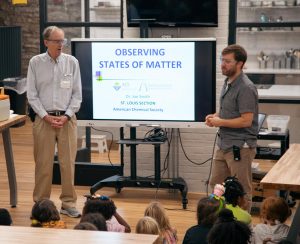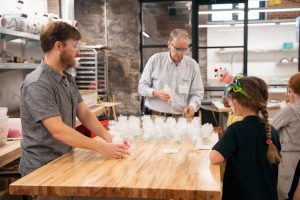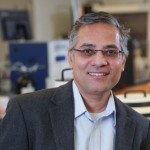
ACS’ Joe Smith (left) and New City School teacher Tom Rankin introduce a presentation to second graders
The 2023-2024 “Chemistry is pHun” outreach program sponsored by the St Louis Section–ACS wrapped up in April as summer break loomed over area schools. Partners in Education, a non-profit that does the substantial work of interfacing with schools on schedules and room reservations, facilitated 19 separate visits to 14 different schools in the Rockwood School District. This year, we added two visits to New City School in St Louis. In total, we gave 37 presentations to 1,389 students, about equally divided between 2nd and 5th and (for New City School) 6th graders.
This year’s program built on the demonstration activities used in previous years with some tweaks in discussing the results. Presentations to both grades began by discussing the diversity of STEM career opportunities. Safety was emphasized by having all presentation participants wear eye protection and by urging students to get adult assistance before experimenting at home.
The presentation for second graders, entitled “Observing States of Matter”, focuses on solids, liquids, gases, and plasmas, and on the role of energy transfer and chemical reaction in causing changes of state. This year, we gave greater emphasis to the energy flows that accompany changes of state. Handwarmers enable students to experience the heat given off during a crystallization reaction. We then discuss what happens when water is frozen in a freezer. The students have already learned that energy must be removed to freeze water. They are then challenged to think about where that energy goes. Students can be surprised to learn that a refrigerator warms up the kitchen when it emits the energy removed to keep the insides cool, plus a little due to inefficiency.

Mixing reagents for a hands-on demonstration activity
Fifth graders experienced a “Transforming Matter” presentation that introduces the concept of chemical reactions. We illustrate combustion and acid-base reactions. This year, we added a discussion of how scientists use models, i.e., simplified representations of complex systems. [As in “Consider a spherical cow”? — Ed.] As a demonstration, we use a cup of water with an acid-base indicator and some vinegar as a “model stomach” with indigestion. We explore how discomfort can be relieved by adding sodium bicarbonate. We discuss how scientists use physical models (like our “stomach”), conceptual models, and computer models like those used to produce weather forecasts. Properly used, simple models can often yield useful insight into how more complex systems behave.
Hearing students’ questions is a gratifying part of giving these presentations. This year, we heard the typical questions, e.g., “How OLD are you?” and “How many years have you been a scientist?”, some thoughtful questions, (“Have you ever regretted becoming a scientist?”) and questions that verge on the profound: “Why does matter take up space?” Giving these presentations is an opportunity for retired professionals to introduce the idea of a STEM career to students in their formative years. If you are interested in participating in future programs, contact Joe Smith.


